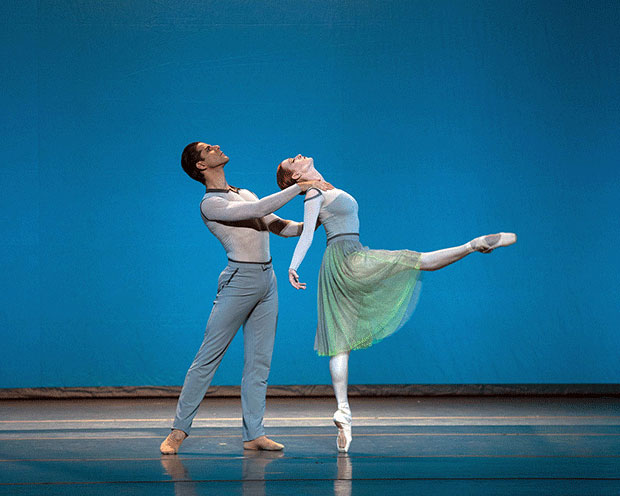
© Rosalie O’Connor. (Click image for larger version)
American Ballet Theatre
Her Notes, Symphonic Variations, Other Dances, Serenade After Plato’s Symposium
★★★✰✰
New York, David H. Koch Theater
19 October 2017
www.abt.org
davidhkochtheater.com
One night after the Fall Gala, American Ballet Theatre (ABT) pulled no punches, programming a long, four piece mixed bill of abstract dances. No one performance stood out as better or worse: highs and lows were scattered across the board, each work shining in its own way, if some more than others.
The program opened and closed with the most recent works: Jessica Lang’s Her Notes and Alexei Ratmansky’s Serenade after Plato’s Symposium. Both premiered at ABT in 2016, and both are works whose inspiration largely comes from their scores.
Lang was struck by the beauty of Fanny Mendelssohn’s “Das Jahr.” The sister of Felix, Fanny composed 13 essayistic pieces at the end of each month as musical souvenirs of a year-long journey with her husband (the 13th was a postlude). The music is pretty, romantic, and can be passionate and brooding in the vein of Chopin. Lang’s choreography is too, and she works in a number of elegant, lilting lifts and with dreamy partnering opportunities for the men and women. Frequently a principal female, on this night Gillian Murphy and Misty Copeland, will end up alone on stage with others milling around them, resting in contemplation, perhaps emblematic of the forgotten female artist.
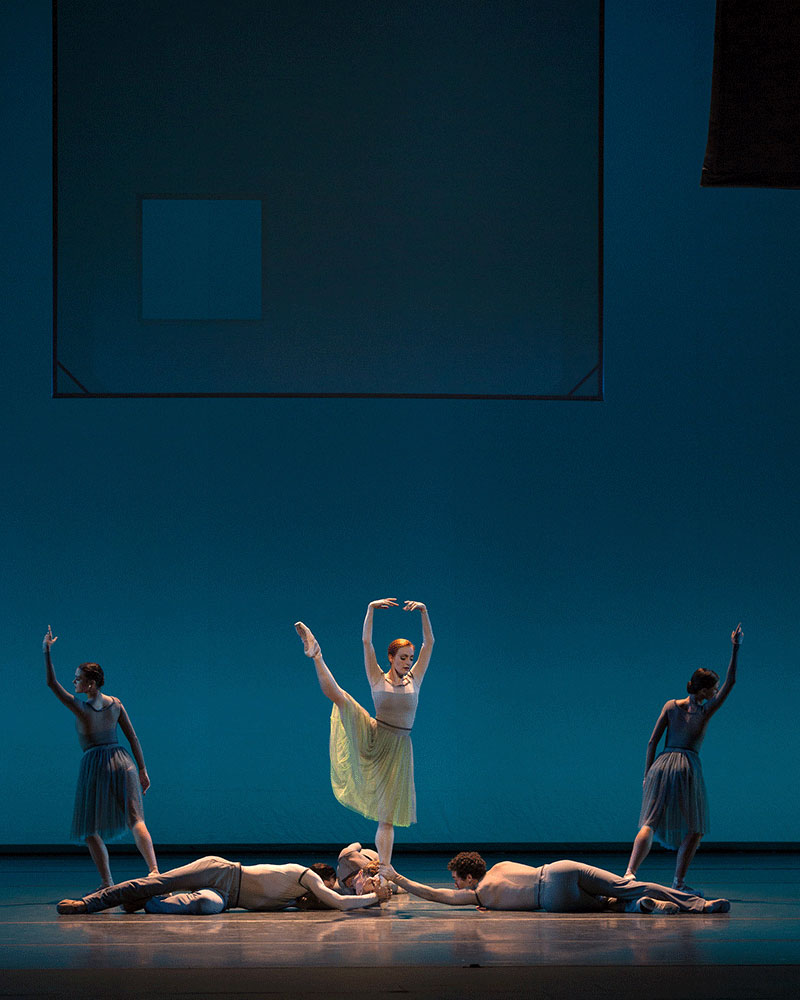
© Rosalie O’Connor. (Click image for larger version)
Ratmansky’s Serenade after Plato’s Symposium is named after the score by Bernstein, a concerto in five movements, all of which are named after orators in Plato’s Symposium on love. The program notes declare Ratmansky’s work as ‘an abstract exploration of some of the themes Plato investigated within his Symposium.’ It does not elucidate what the different dialogues are about, nor name any characters. Given that Bernstein titled the movements after the men present at the Symposium, and wrote ‘guideposts’ for each, explaining the themes discussed (neither of which are referenced in the program), this ‘abstract exploration’ seems to be false advertising. Love can seem abstract, but the discussion and the people are not. Plato’s Symposium has a narrative, and to shirk this or refer to it without reminding the audience who Alcibiades and Aristophanes were, or the topics they discuss (desire, its origins and nature, etc.), seems a way to avoid being held accountable for visualizing some of this in dance. Why use seven men if they are not named, nor their themes delineated? An abstract work could explore aspects of the dialogue with more or less dancers, without any reference to the source material. Ratmansky gives us a half-literal, half-abstract concoction which leaves clarity wanting.
What Ratmansky does get across, very well, is the act of discussion, of dialogue itself, through the play of choreography. You may not always know who is who, or what they are saying, but you get they are having a spirited chinwag, and that admiration, longing, sex and attraction are part of it. Ratmansky’s gifts for male choreography shine in Serenade after Plato’s Symposium…which is a dazzling spectacle for ABT’s legion of talented danseurs.

© Rosalie O’Connor. (Click image for larger version)
Thursday night Herman Cornejo, Blaine Hoven, Alexandre Hammoudi, Calvin Royal III, Gabe Stone Shayer, Daniil Simkin and James Whiteside lit up the stage in a blaze of fire and virtuosity. The difficulty of the steps is immense but well-hidden, and the men look crisp, comfortable and well-rehearsed. Simkin was smug, full of Bolshoi-esque swagger and flourish, while Whiteside combined an unkempt John-the-Baptist look with slink and sex. Hoven luxuriates in his own hip movements enough to make you cry. Steps swing from the fast and fiendish to the sensuous and sweeping. There is much contrast, with love bringing light and loft as much as it brings weight. The brightness fades when Devon Teuscher enters the stage – though this is not her fault. Like the men, she is not given a character in the program, but as the only female she must be Diotima, and her lifts with Hammoudi were rather awkward, clunky and unflattering.
While each work has its merits, the Lang and Ratmansky both suffer from a similar flaw: the choreography of each, in certain moments, is overshadowed by the music. While not unmusical, both Notes and Serenade get busier than busy, one could even say cluttered with ensemble entanglements, and a plaintive piano or a soaring violin string can seem ignored in a flurry of complexity.
On the other end of the spectrum is Ashton’s Symphonic Variations, a masterpiece known for its harmonious marriage of music and movement. This would have been more evident Thursday night had the dancing been not just tighter, but more at ease. Even when he appears to be simple, Ashton is hard, and on Thursday most of the dancers looked as if they had clenched teeth. Symphonic is unforgiving but must look emblematic of celestial classicism. With the whiff of Balanchine in the air, different executions of epaulement and timing do not suit Symphonic, which is a piece of utter precision. Performed with earnestness by Misty Copeland, Christine Shevchenko, Skylar Brandt, Arron Scott, Calvin Royal III and Joseph Gorak, Symphonic fell short of reaching its sublime heights but did show promise with this cast.

© Rosalie O’Connor. (Click image for larger version)
A happy marriage of music and movement was Jerome Robbins’ Other Dances. Set to four mazurkas and a waltz by Chopin, Other Dances was created by Robbins for Natalia Makarova and Mikhail Baryshnikov in the mid-70s, and was meant to sizzle.
Partnered by David Hallberg with Emily Wong on piano, Hee Seo looked ravishing in Other Dances. With a mischievous smile playing on her lips, Seo flicked and flexed to the mazurka, both her own woman and channeling the dancer on whom it was created. Seo anticipates Hallberg as she turns her head (he only looks at her when he arrives across from her, never before). In the duets, Other Dances is a courting ritual of peacock and coquette, in the solos, it is an empty room with nothing to do but dance. Each dancer a master of their own self, Other Dances exudes autonomy in solitude and in sex. Hallberg tries to match Seo’s sass, and he comes close. He throws himself into the virile, folk-inflected choreography, but remains overly self-involved as a partner – a flaw in dramatic approach rather than technique. But his spirit was in it to win it, if he could just ditch Narcissus mode, he’d be in business.












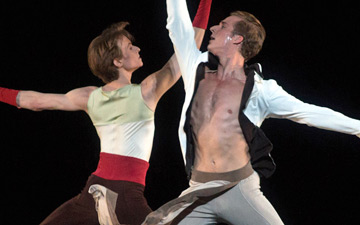
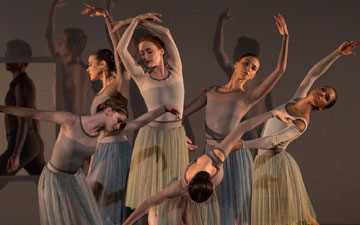
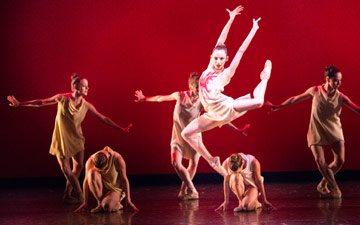


You must be logged in to post a comment.